Introduction
Since 2014, PowerToFly has been elevating underrepresented talent and helping organizations build inclusive, representative workplaces where this talent can thrive. That’s a decade’s worth of workplace diversity, equity, inclusion, and belonging (DEIB) efforts, and a decade of witnessing both wins and losses in this space.
We’ve seen inequitable work cultures and policies held to account during #MeToo and after the 2020 murders of George Floyd, Breonna Taylor, Dominique Fells, Riah Milton, and far too many other Black Americans. We’ve seen major boons in salary transparency and “ban the box” laws, as well as the increased adoption of DEIB trainings and initiatives covering neurodiversity, disability, age diversity, gender identity and expression, and more.
We’ve also seen the outright removal of rights for many identity groups, and stalled progress for others. In the United States:
- The right of trans and gender non-confirming folks to simply exist is at risk.
- Workers in many states are reliant on things like their employers’ PTO policy in order to travel distances for needed and, at times, life-saving reproductive healthcare.
- And a probable nominee for president has made clear his intention to begin mass deportations and reinstate a “Muslim ban” if reelected.
Against this backdrop, and following the 2023 reversal of affirmative action and subsequent ban of DEI programs at some public universities, the future of workplace DEIB has been called into question. So far, a divided response between corporate leaders over the best way to shore up and protect DEIB is evident.
But the primary goal — shoring up, protecting, and continuing with this work — remains a securely shared one. In a September 2023 PowerToFly forum for executives, 56% said they were either maintaining or increasing DEIB spend in 2024, while just 9% said they were decreasing it.
To effectively continue with DEIB work amid sweeping social, legislative, and environmental changes, the same approach we’ve always advocated for is required....
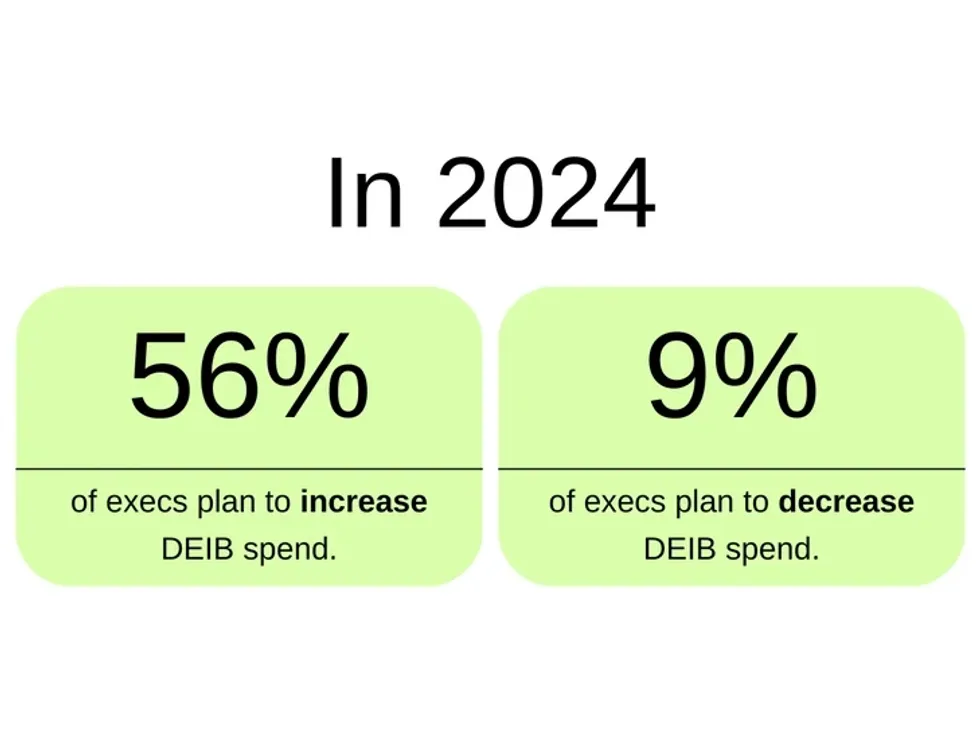
If you want to understand how best to elevate underrepresented talent in the workplace, go to the source and ask them.
Data-driven decision-making is at the heart of business intelligence. Before we figure out where we’re going, we need to know where we are. Diverse professionals are facing new challenges in 2024, and it’s more important than ever to listen to what they have to say.
For PowerToFly’s fourth annual What Diverse Talent Wants report, we surveyed 600+ professionals across backgrounds and identities about what they need to see from their existing and prospective employers — in terms of practices, benefits, professional development opportunities, work cultures, and more — in 2024. We then analyzed and distilled that data into strategic, actionable recommendations that organizations can implement today.
From our reporting and analysis, we learned that diverse professionals want employers to do the following in 2024:
- Invest more in learning and development.
- Pay what you preach.
- Don’t forsake flexibility.
- Rethink the candidate experience.
- Solve today’s employee connection crisis, for good.
- Double down on DEIB.
Forget manual work and embrace efficiency with
PowerToFly's all-in-one diversity recruiting software.
Our data reveals a trend of increasing worker dissatisfaction.
A full 88% of all respondents to our survey (both employed and not employed) are actively job searching.
Back in 2023, we saw a decrease in workers’ intent-to-leave, indicating that the effects of the Great Resignation had attenuated. That rate is back up in 2024, with 59% of currently employed respondents actively considering quitting their job this year, compared to 49% in 2023. Another 24% aren't yet sure whether they'll consider quitting.
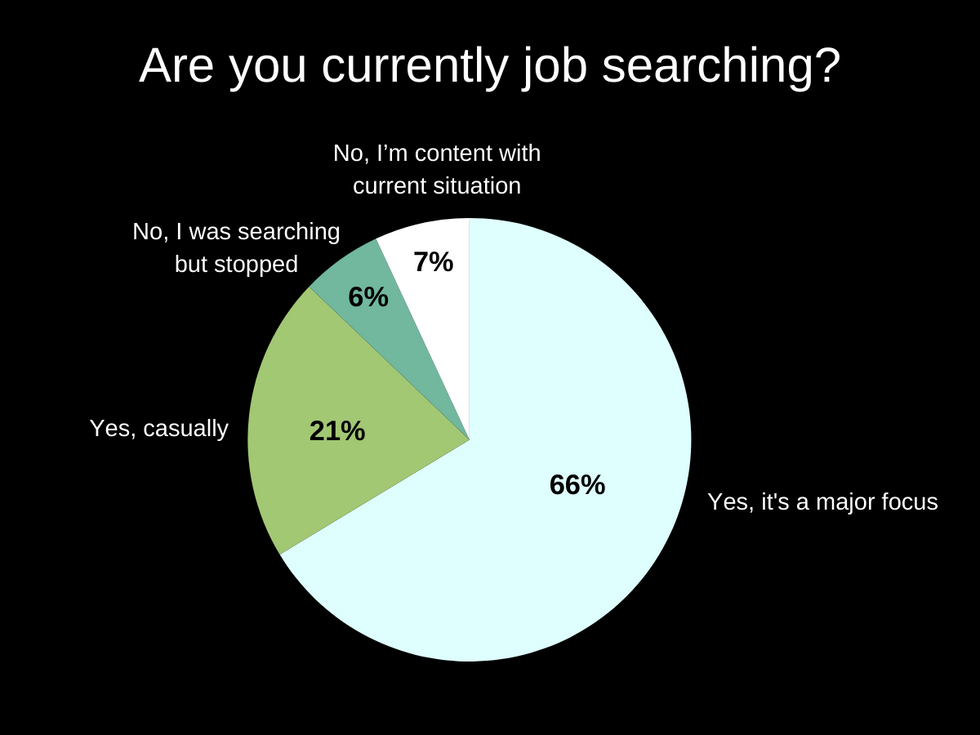
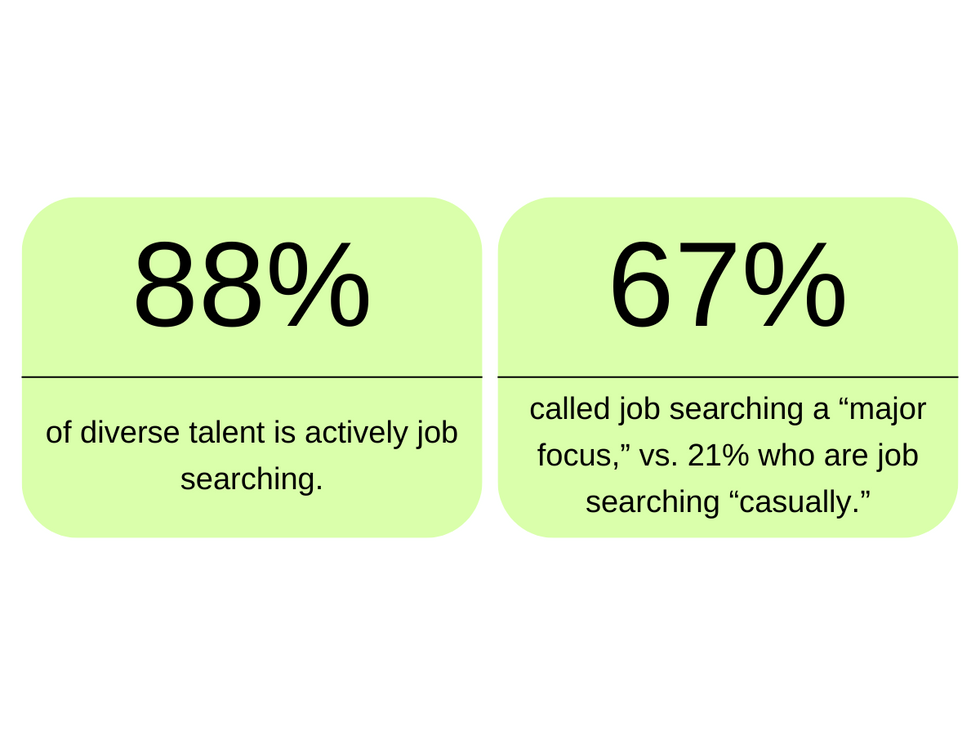
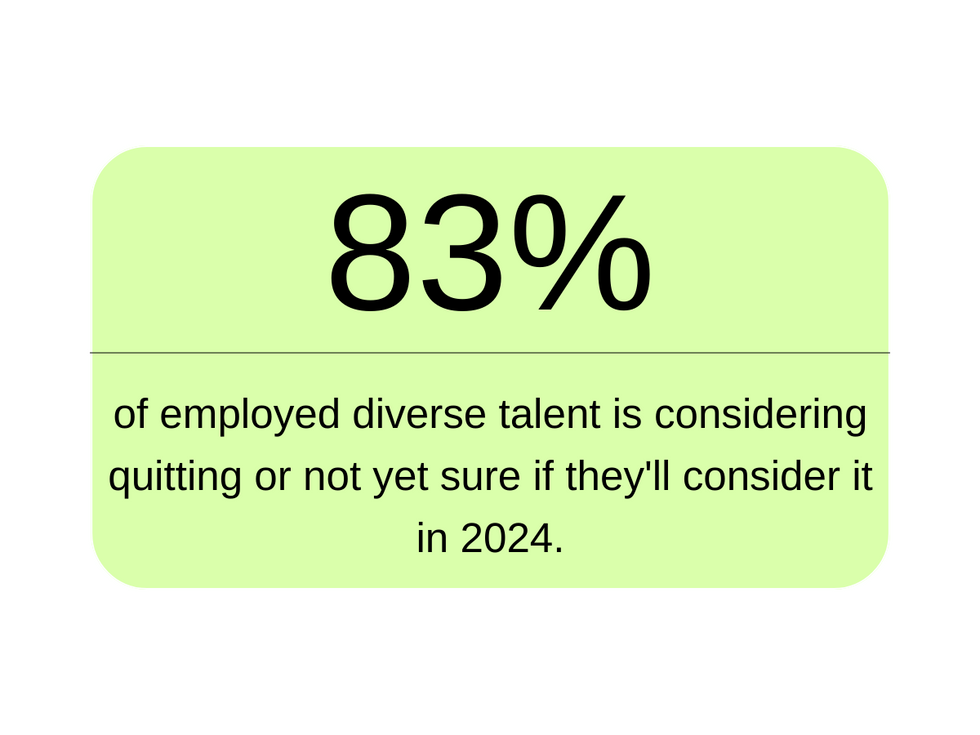
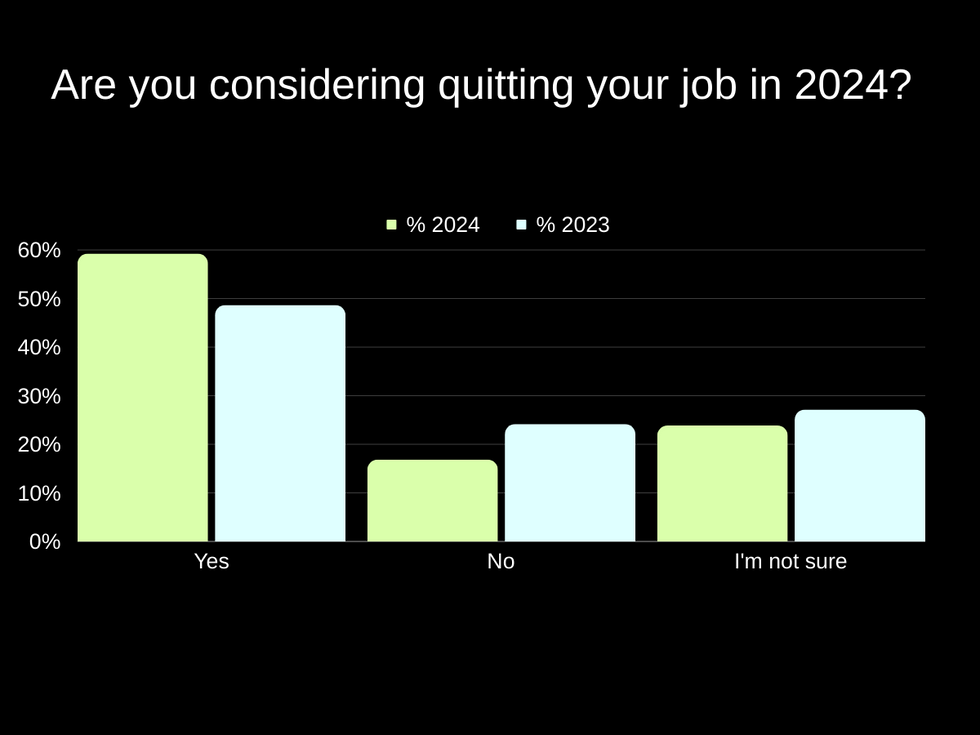
So, where is this worker dissatisfaction coming from?
In 2024, workers are facing challenging experiences in — and out of — the workplace.
We’re told the U.S. economy is stronger than it has been in years, and yet, Americans are stuck in a bad “vibes-cession.” In lieu of stronger social safety nets, navigating rising costs of living remains ultimately tied to workplace benefits and employer decision-making. And, as organizations rapidly change (and change again) the way they do business, workers are left feeling stressed and disconnected.
The Great Resignation led to a high in worker choice and autonomy, but major layoffs from top companies in 2023 have driven feelings of insecurity. Our 2024 survey found that only 44% of underrepresented workers feel confident in their job security, compared to 60% in 2023.
Notably, when breaking out our 2024 data according to gender identity, confidence in job security is still 60% for men. Meanwhile, only 43% of women and 0% of trans and non-binary respondents were confident in their job security.
And what about the fear of starting a new job only to lose it? Our survey found that nearly half (47%) of underrepresented workers have been laid off at some point in their career — slightly higher than the national average of 40% — and 1-in-5 were laid off in 2023.
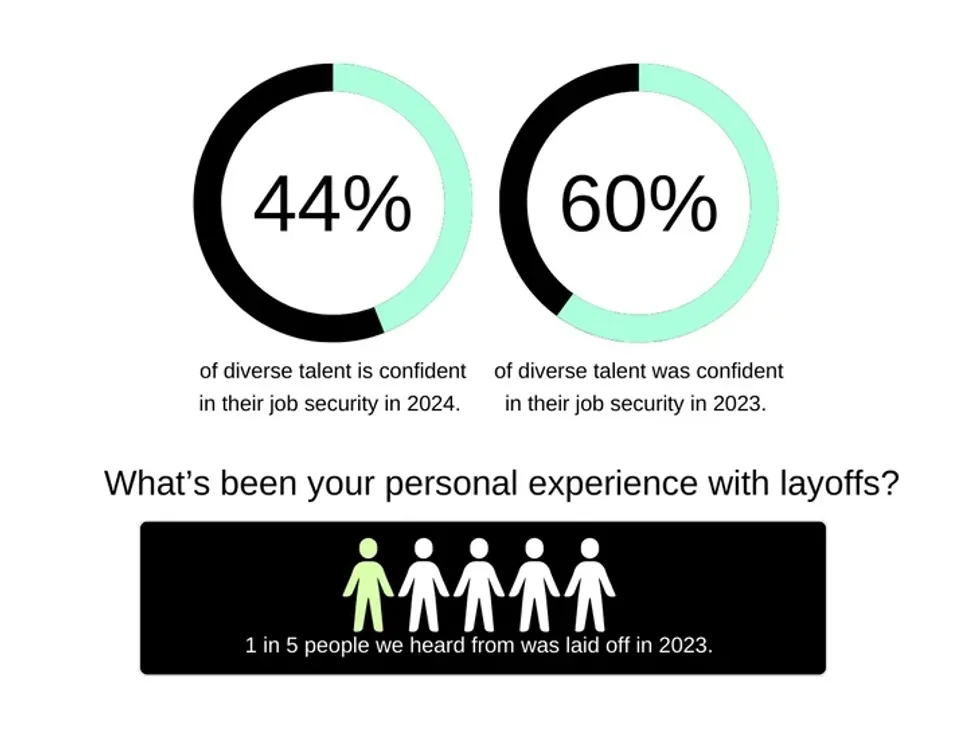
Other factors adding to today's environment of worker insecurity and dissatisfaction include:
- Positive economic gains, like a low unemployment rate and strong consumer spending, are overshadowed by long-term economic challenges, like growing inequality and housing and healthcare affordability, leaving workers feeling worse about the economy now than they did in the depths of the COVID-19 pandemic.
- Workplace policy has also driven dissatisfaction in the daily lives of employees. In 2023, a wave of back-to-office mandates led to significant pushback from workers. That battle ended in hybrid work arrangements that, in many cases, now skew more heavily toward in-office work. Given that PowerToFly started in 2014 with an emphasis on remote job opportunities, it wasn’t surprising that most of our survey respondents are still in fully remote (47%) or hybrid (29%) roles. However, our number of respondents who say they’re fully in-office has ticked up 8% since 2023, and there's concern over a loss of location flexibility in future roles.
- On top of that, employees are feeling overworked. The average worker today is responsible for the work of 2.3 roles beyond their specified job. Globally, U.S. employees work some of the most hours per year — more than Japan and in Europe.
- Meanwhile, Generative AI captured the world’s attention in 2023 — and left many workers feeling underprepared and worried about future industry impacts. Research from Accenture shows that while nearly all workers (95%) see value in working with AI technology, 60% are concerned that it could lead to job loss, burnout, and stress, and just 5% of organizations are providing relevant skills training.
Despite all this, worker engagement is actually high.
Dissatisfaction and intent-to-leave rates may be high, but our 2024 data showed that engagement levels among underrepresented workers are high, too. Some 76% of respondents report being either "somewhat" or "very" engaged at work, and just 4% say they’re "very disengaged."
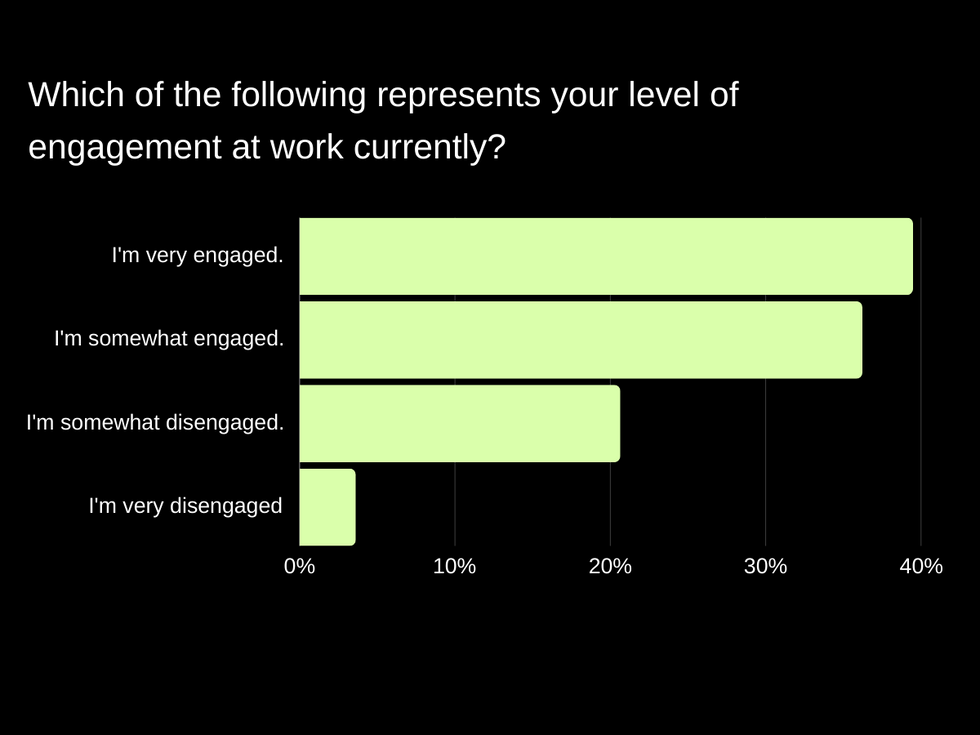
This means the worker dissatisfaction we’re seeing is not burnout. It’s distrust and discontentedness over “shouting into the wind.” In other words: Despite high effort and engagement, workers aren’t feeling rewarded with the job security, advancement opportunities, and pay they desire in return.
These feelings of not being heard or cared for open several opportunities for organizations to step up and truly set underrepresented workers up for success, including by prioritizing:
- Upskilling and professional development, including on platforms like PowerUp
- Salary transparency
- Flexibility
- An improved candidate experience
- Rebuilt employee connection and relationships
- Strengthened DEIB
To arrive at these recommendations for the 2024 What Diverse Talent Wants report, we talked to a pool of 634 diverse professionals. Of that group:
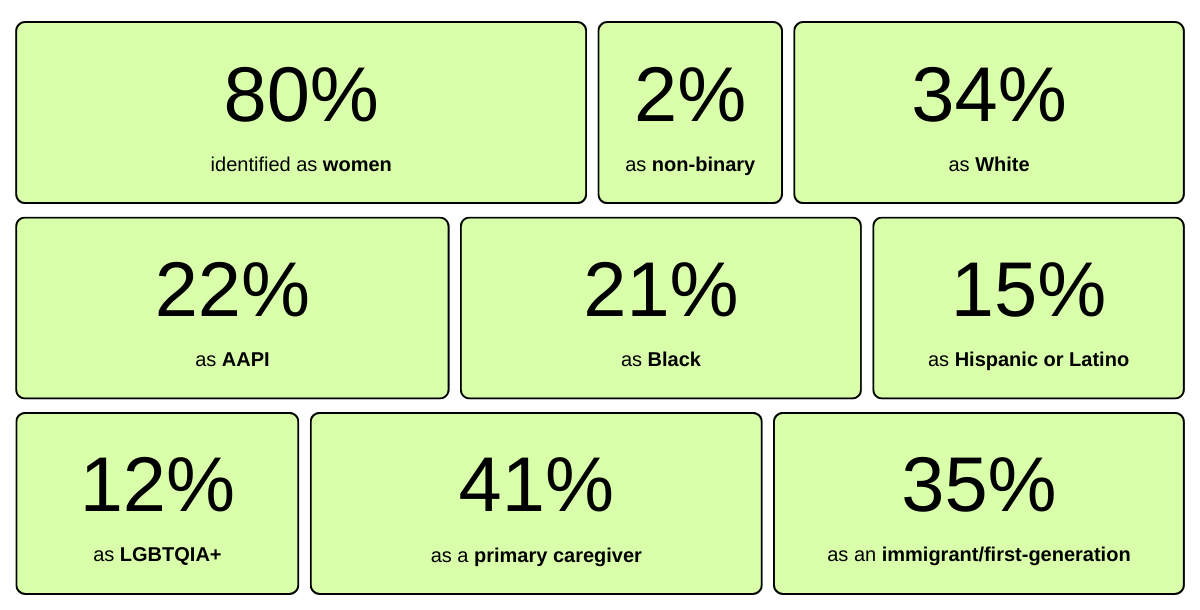
Now, let’s focus on what the data shows us — and what organizations can do about it.
Contents
- On learning and development
- On transparent pay (and more of it)
- On the candidate experience
- On connection
- On DEIB
- In their Words: Direct feedback from talent
- Next steps and recommended resources
- Methods
1. Invest in learning and development.
One of the most consistent takeaways from our survey data? Underrepresented workers want more professional development and learning opportunities at work this year, and lots of them. Consider: A full 91% of respondents said they want to see more upskilling from employers in 2024.
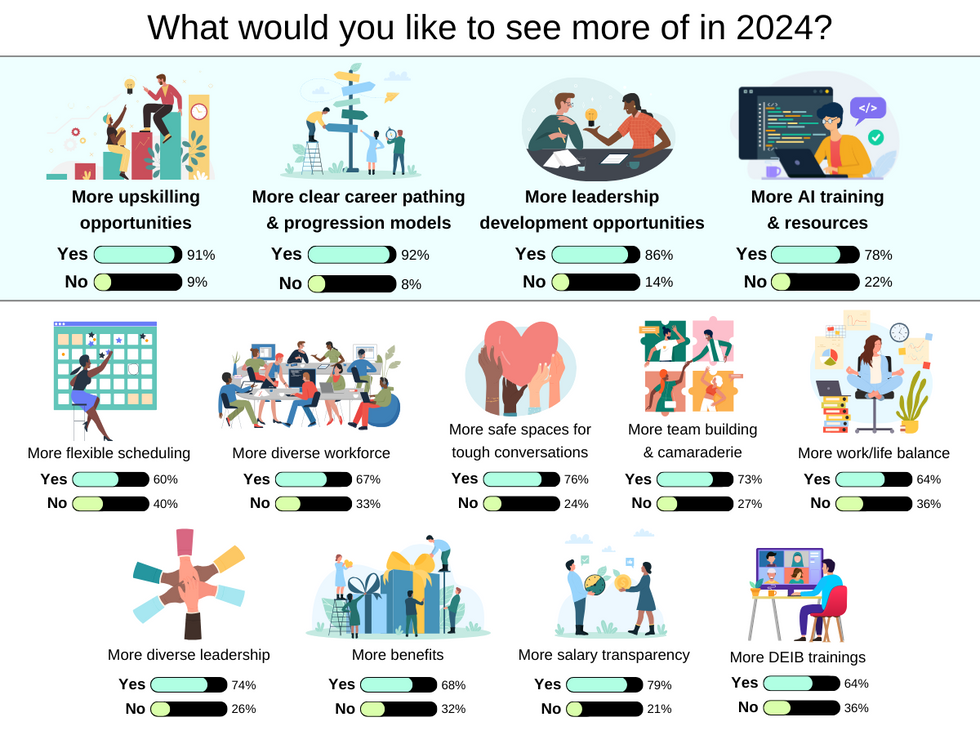
Also in respondents’ top five 2024 wants: Clearer career pathing and progression models, more leadership development opportunities, and more AI training and resources. These were all ranked above benefits like work-life balance and flexible scheduling, despite the fact our survey also found a downward trend year-over-year in work-life balance satisfaction. (More on that later.)
So, why the major emphasis on learning and development?
Our theory: After years of a pandemic, economic and legislative uncertainty, and pendulum-swinging disruptions to the way we work, people want to see their companies invest in them in a way that’s proven to provide security and upward mobility.
Bells-and-whistles benefits are great. But without clear, organized, and invested-in systems of support to help underrepresented professionals develop and grow in their fields, stability is hard to reach. That’s especially true as the widespread adoption of AI promises to disrupt the way work is done yet-further; it’s no coincidence that 78% of survey respondents want more AI training and resources this year.
Our survey also showed racial and gender identity-based trends in the value that workers place on upskilling and L&D.
While 88% of respondents who identified as men wanted more upskilling in 2024, 91% of women and 100% of non-binary respondents wanted it, as did 100% of trans respondents. Relatedly, when asked how likely they’d be to leave their current job for a position that afforded more L&D in 2024, 61% of White respondents said they would leave while 77% of Black, 81% of Latino, 73% of Asian, and 80% of Indigenous respondents would.
As you look to answer diverse talent’s call for more upskilling and development in 2024, what are the areas where workers today want to grow the most? We put it to our 600+ survey respondents. Below, check out which skills they wanted to grow the most in 2024, then read on for actionable strategies to bring more L&D into your workplace in 2024.

2024 action items
Create or revisit your ongoing education stipend.
Education stipends are a key resource for employee learning and professional development. Your stipend should be flexible so that an employee can apply it to a passion or interest of their choice. Federal tax allows a tax-free educational stipend of up to $5,250 per year. Industry leaders like Google, Visa, T-Mobile, Chase, and many others offer the top range and beyond.
Start a mentorship program.
Mentorship is a working relationship that supports the professional and personal growth of both mentor and mentee. Many mentorships begin informally, which can leave people unsure of how to find a mentor and can also increase the odds of affinity bias between mentors and mentees. Having a formal, developed mentorship program at work gives every employee access to these powerful relationships. (Note: We’ve also seen the impact that can come from giving underrepresented workers space to connect as peer-to-peer mentors outside of company-owned channels, too.) To get started with a mentorship initiative, define goals, outline your process, identify potential mentors and mentees, and match them.
Promote psychological safety in the workplace.
Psychological safety is the feeling that you can share your ideas, questions, or mistakes without punishment or humiliation. It’s a key element of whether learning exists or can’t in a workplace. Provide training on psychological safety to managers and teams. Managers should demonstrate curiosity, frame work as a learning process, and respond positively to feedback from employees.
Explore online training and upskilling courses on PowerUp.
Subscribing to PowerToFly’s online learning and development platform, PowerUp, unlocks a library of self-paced, expert-led courses for you and your team. Check out the 2024 course catalogue, which includes inclusive AI training, and gain SHRM and HRCI recertification credits for each course you complete. You’ll also get access to resources like crash-course videos on key DEIB subjects, templates, a 2024 DEIB calendar, trending news, and more!
2. Pay what you preach.
Remember that rise in worker dissatisfaction we talked about?
Dissatisfaction was up across a number of core areas for our 2024 survey, and salary tops the list. A full 50% of respondents were either "very" or "somewhat" dissatisfied with their salary in 2024, up from both 2023 (44%) and 2022 (43%).
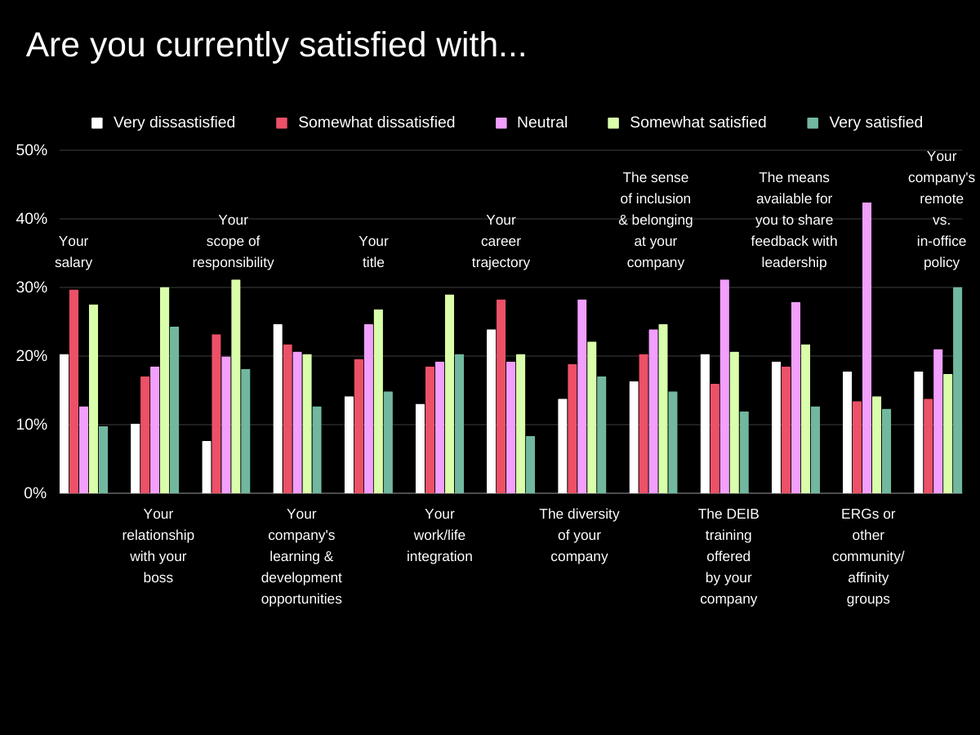
Tellingly, our survey data showed strong differences in salary sentiment when broken down by racial identity. While 44% of White respondents were either very or somewhat dissatisfied with their salary, the same was true for 64% of Black respondents, 54% of Asian respondents, and 46% of Latino respondents — a pattern that makes sense when you consider ongoing racial wage gaps.
Let’s reiterate the obvious: Underrepresented workers want to grow, advance, and, yes, be paid for it.
Pay may not be the only thing that matters, but let’s not undersell its importance — it matters. That’s particularly true against a backdrop of rising costs of living, rising workloads, and a feeling that your company may not have a clear plan for how they’ll upskill and develop you, helping you to reach higher pay thresholds. Consider this related finding: 46% of our survey respondents were either very or somewhat dissatisfied with their company’s learning and development (L&D) opportunities.

Salary and L&D also both ranked high for reasons diverse talent would leave their current role to pursue a job with a new company.
In our survey, 98% of underrepresented workers said they’d be either somewhat or very likely to leave their existing job for better pay in 2024 — up 7% from our 2023 survey — and 94% said they’d be somewhat or very likely to leave for better L&D, up 6% from 2023.
A need for more transparency was also a clear throughline of the survey, with a desire for more salary transparency – something 79% of all respondents and 87% of LGBTQIA+ identifying respondents wanted – fitting in alongside asks for more transparent career pathing and progression models.
Consider: For the diverse professionals who reported being “very dissatisfied” with their job titles in our survey — something that was true for 23% of Black, 16% of Asian, and 14% of Latino respondents, compared to 10% of White respondents — clear career pathing offers a fixed, transparent template for upward mobility, rather than that mobility being left to the whim of a potentially biased manager who doesn’t share in your demographics.
2024 action items
Promote salary transparency from the start.
States like California, Colorado, and New York are now requiring that salary ranges be posted within job listings, and for good reason — policies of salary transparency improve trust and lead to more efficient talent acquisition, better employee retention, and increased productivity. Embracing this policy will get you a lot more qualified applicants, especially the more specific you get. Include in job postings clear, detailed explanations behind your salary range’s different brackets, and share specific information about bonuses and/or variable compensation upfront, too.
Offer financial wellness benefits.
DEIB-backed employee benefits address the systemic inequities affecting diverse talent. Actions like covering 100% of healthcare premiums go a long way towards easing the “bad vibes” surrounding today’s rising cost of living. Finance-specific initiatives focusing on financial inclusion can also give underrepresented talent access to the types of financial services usually very familiar to those in the highest socioeconomic brackets. Offer your employees quality financial counseling, advice, and education. This can include economics workshops, free investment consultations, annual contribution matching, and other financial health benefits that contribute to wealth building.
Conduct a pay equity audit.
An audit is a necessary first step to embracing salary transparency and ensuring equal pay. To get started, make a company-wide list of salaries according to work history, cross-referencing demographics information. Make note of any discrepancies that align with protected categories of talent and take immediate action to fairly compensate employees retroactively, based on their start date. When finished, transparently share your audit results with employees, and publish any updates to set salary ranges by level and position.
Recognize pay’s role in work-life balance.
According to our survey, more people are unhappy with work-life balance than in years prior: 32% of respondents were either very or somewhat dissatisfied with their work-life integration in 2024 versus 24% in 2023 and 27% in 2022. Why mention this in regards to issues surrounding pay? Ultimately, a generous salary is a major factor in employees’ ability to enjoy their lives outside of work. Adequate compensation contributes to a balanced life, and a sense of “all work and no play” can be tempered when free-time activities, like travel, are more financially within reach. And outside of taking vacations, being able to afford good childcare or eldercare for aging parents can hugely impact workers’ day-to-day work-life balance.
Power your recruitment efforts with our proprietary diversity data and AI-driven candidate search.
3. Don’t forsake flexibility.
Salary and advancement potential aren’t all that diverse professionals are prioritizing. Job flexibility was identified by 91% of respondents as a key factor when searching for a new role. And in another question, respondents ranked a fully flexible 40-hour schedule as more popular (45%) than both a four-day work week (27%) and a five-hour workday (13%).
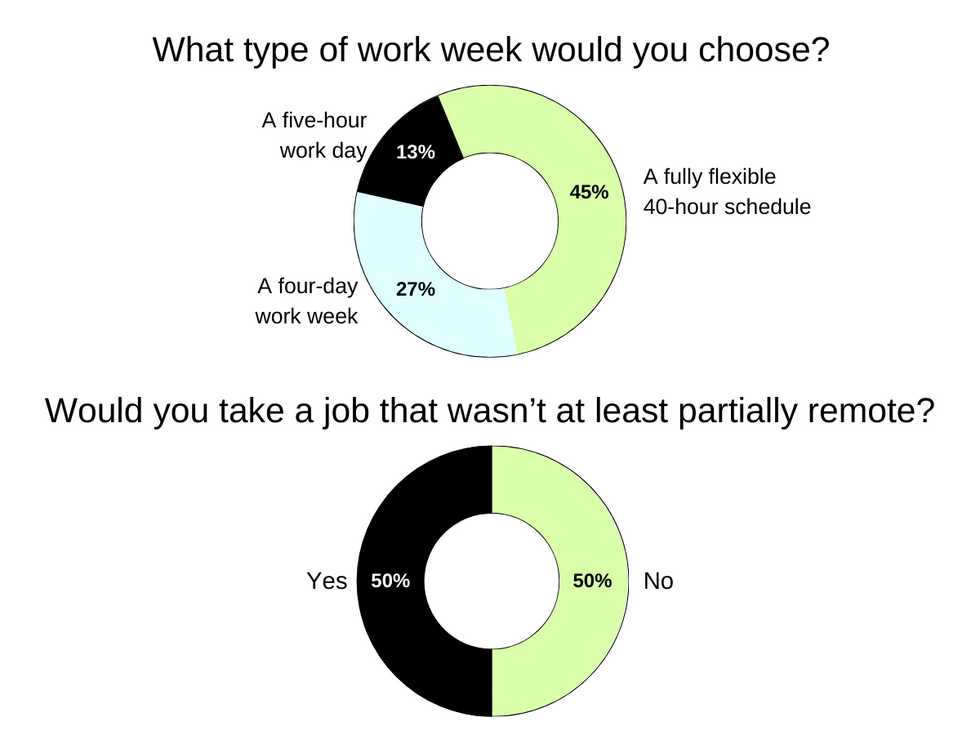
Meanwhile, where employees work — remote, in-person, or hybrid — had respondents divided, with 50% saying no remote option was a deal breaker and 50% saying it was not, undoubtedly following a trend of fully remote roles drying up.
At the height of COVID-19’s emergency transition to home offices, close to half of Americans worked from home full-time. As of 2023, less than 10% of workers in the U.S. had a fully remote job. From March to November 2022 alone, all-remote jobs on LinkedIn fell from a high of 20.6% of job postings to less than 14%. A Stanford economist predicts that trend will continue, citing formerly remote positions getting outsourced abroad as well as replaced with AI.
But location and schedule flexibility still matter — and may matter even more to less-represented talent groups.
Our own survey found that while 48% of White respondents were “satisfied as-is” with their company’s flexible scheduling policy, that was true for just 38% of Latino, 37% of Black, 32% of Asian, and 0% of Indigenous respondents. Similarly, while 43% of White respondents were “satisfied as-is” with their company’s work-from-home policy, only 35% of Black, 32% of Asian, 24% of Latino, and 0% of Indigenous respondents were.
How to explain this racial gap in workers' flexibility satisfaction?
To start with, the type of hybrid or fully in-office job that had temporarily converted to a remote position during COVID is distinct from the type of job that will continue to be remote. For example, according to a London-based economist, remote jobs in finance will continue to be available. Labor market analysts at Lightcast report that remote jobs still make up 22% of open roles in finance in 2023, down less than one percentage point from a year before. Add to that the fact that 73.6% of finance professionals are men and 71.9% are White, and we may be able to pinpoint why those respondents would be more satisfied with the way things are than others.
Data has repeatedly shown that flexible work policies, when implemented well, are beneficial and outright necessary for many underrepresented groups at work.
Consider: Disabled people have long been vocal about needing remote work opportunities. The advent of remote work options during the pandemic led to the highest employment rate in that demographic in over a decade. The “remote revolution” also led to a marked increase in employee experience scores for Black knowledge workers, who reported a greater “sense of belonging” at work (up 24%), higher “value of relationships with coworkers” (up 17%), and a stronger perception of “feeling fairly treated” (up 21%).
Who reports wanting flexibility the most? According to our survey: 70% of primary caregivers want more flexible scheduling, compared to 56% of non-caregivers. Just 30% of caregivers were satisfied with their company’s current scheduling policy, versus 44% of non-caregivers.
Though not all women are caregivers and not all caregivers are women, our data does show overlapping attitudes between the two demographics: 74% of women said they would leave their job this year if it was for a company with better WFH policies, compared to 56% men. A UCSF legal scholar explains that the typical corporate work schedule, with its travel requirements and late hours, was not designed with women, or any other gender identity besides men, in mind. It’s a heteronormative framework meant for “men married to homemakers” — and not for anyone tasked with significantly higher rates of housework and caregiving responsibilities, as well as a full-time paid job.
With the sea wave of reversals on WFH and remote policies, much of the relief for groups who flourished under these policies is disregarded. And companies that adopted — then tossed aside — flexible policies stand the risk of gaining a reputation for performative allyship over lasting inclusion.
2024 action items
Transition to flexible schedules.
In order to switch teams to flexible schedules without sacrificing productivity, Forbes recommends a pilot project. Start with a small team of high-performing employees and monitor success by gathering feedback — and data — from both the manager and team members. Starting out flex schedules on a trial basis allows you to work out any challenges that may arise in real-time.
Train your managers.
Forbes points out that without the skills and competencies to manage a remote workforce, managers could become the weak link that leads to reduced productivity or even program failure. Don’t miss out on the opportunity for improved employee satisfaction and retention in 2024. Set up your managers for success. Seek out and provide managerial training that focuses on active engagement, accessibility accommodations, and hybrid work best practices. Managers that lead distributed teams with trust and evaluate employees based on performance (rather than on facetime, AKA proximity bias) will find the most success.
Retain core business hours.
One thing that could slow down with flexible work scheduling is communication — but it doesn’t have to. Though it may differ based on geographic spread or local culture, take a look at 10 a.m. to 3 p.m as an example. Early morning is typically for catching up on emails. Late in the day, people are meeting deadlines, finishing projects, or beginning to be concerned with responsibilities outside of work. The middle of the day is when people are most available and attentive to live communication. By setting a mandatory window when everyone is on the clock, you ensure that your teams are still accessible for time-sensitive information while giving them freedom from the 9-to-5 workday.
Expand use of remote communication tools.
In the absence of real-time communication, it’s crucial to use platforms and tools that combine fluid communication with convenience. Take Loom, a screen-capture extension in Google Chrome that gives you the ability to create and share screen-recorded videos with synced audio. Managers can send training videos to their teams when sharing a screen in real-time can’t happen. Another tool is the WhatsApp voice recording feature in chat mode, popular in Latin America but hardly utilized in the U.S. It allows information-rich audios to be sent and listened to at each user’s convenience and is especially great when typing out a message in Slack or email isn’t the most efficient use of time. It’s also perfect for conveying the right tone for a sensitive message when a live conversation can’t be scheduled.
4. Rethink the candidate experience.
How potential candidates experience a job application process is critical. Candidate experience (CX) factors into not only whether someone applies to and accepts a job, but also their lasting impression of the company as an employer.
With 88% of our survey respondents actively job searching, CX is a key way that underrepresented talent experiences a company regardless of whether a job is taken there. When CX is overlooked, the results are lasting: About 64% of respondents had a negative candidate experience that hurt their relationship with a company long-term, with 27% going so far as to say they'd neither apply to that company again or be a customer of it, which is backed up by IBM research.
What kinds of negative CX practices did our survey respondents report experiencing?
- Over 59% were ghosted by a recruiter or hiring manager
- Over 73% received an auto-reply rejection
- Over 34% were informed the role they interviewed for would no longer be filled
- Over 25% were asked to do unpaid work as part of the interview process
- Over 44% reported seeing inaccurate job descriptions for a role
- Over 38% felt an employer used a “ghost” posting to falsely build candidate pipelines
- Over 55% reported seeing unreasonably low salary ranges in posts
Any one of these practices can easily lead to a negative employer reputation on the job market, permanently harming your employer branding efforts and ultimately hurting your bottom line. And with so many underrepresented workers finding themselves on the receiving end of these practices, it's hardly a surprise that attitudes about job searching are what they are. In our survey, 48% of respondents said that job searching today is "harder than ever."
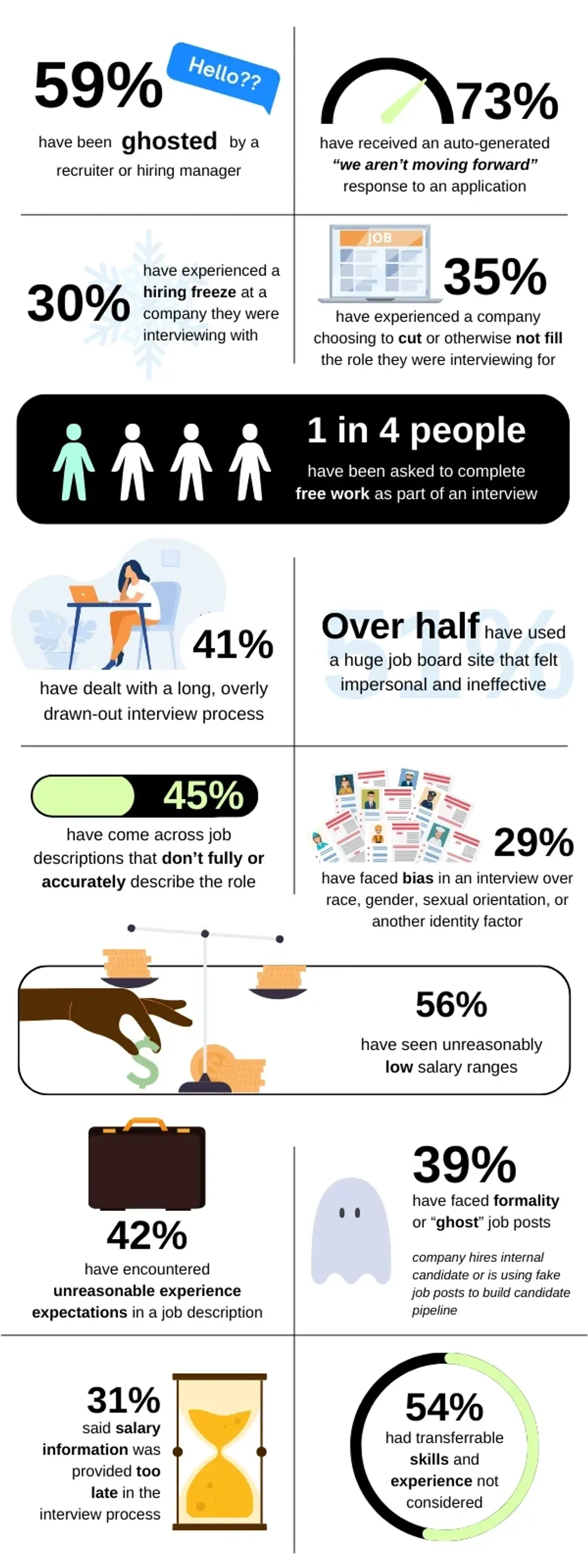
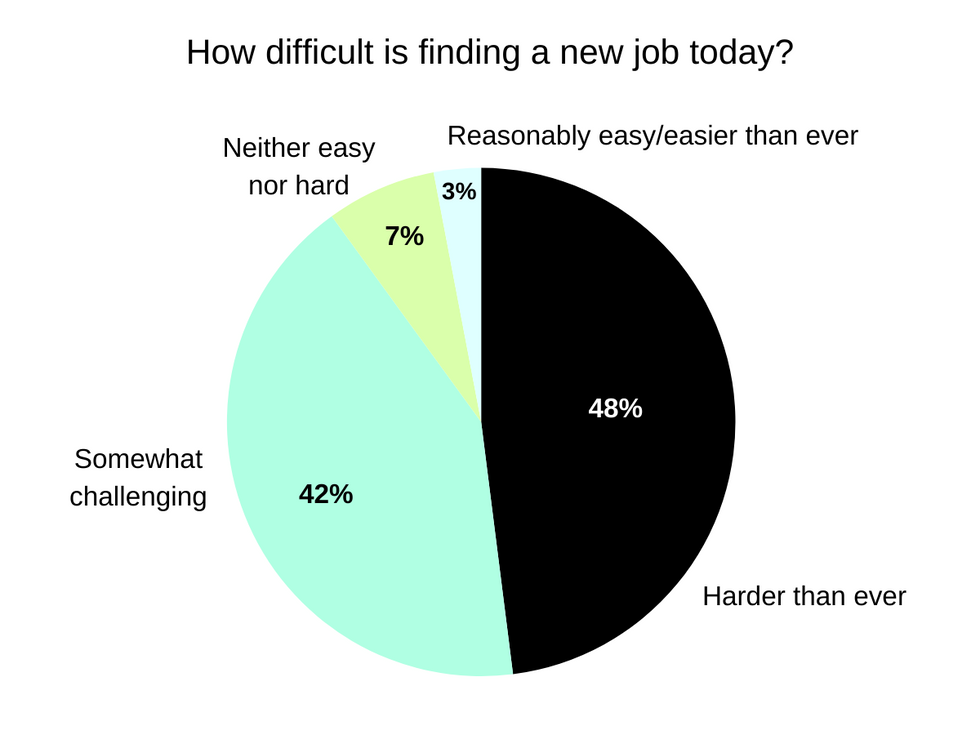
Employers need to take considerable action now to improve and humanize their talent acquisition efforts, particularly as the emergence of GenAI heralds an era of increased automation in hiring.
2024 action items
Start with inclusion.
An inclusive talent acquisition strategy is your baseline for a positive CX. Incorporating DEIB-backed inclusive hiring practices and using the right KPIs throughout your talent-seeking and hiring processes will prevent exclusionary practices and help diversify your workforce. And avoiding the impersonal negative practices our survey respondents reported above will improve your employer brand among the talent pool of diverse backgrounds and identities you’re targeting. For help identifying more opportunities to embed inclusion into your hiring process, pull in DEIB consultancy services like the ones offered by PowerToFly.
Implement paid tests only.
Tests are a good way to focus on skills and competencies in an interview, but to a candidate, they’re also hours worked. Paying applicants for their assessment time will help your organization stand out in a crowded job market.
Banish the "application black hole."
In 2024, make every effort to make job searching feel like less of an impersonal process for diverse applicants. Don’t allow applicants to drift into a “black hole” where the odds of being ghosted or getting auto-generated responses are high. To that end, be smart with technology. You can use platforms like PowerPro to help you track, manage, and move candidates along every stage of your recruitment funnel. Direct-message talent, leave notes and comments for your hiring team in one centralized place, and make sure no one falls through cracks.
Automate wisely.
Many companies have automated responses as part of their digital transformation. When it comes to moving people through an interview process, though, here’s a revolutionary concept: eliminate the auto-reply. As AI becomes more embedded in our talent acquisition and management efforts, we need to be mindful about the way we're applying automation in general, but especially where the candidate experience is concerned. Though it’s time consuming, invest in your employer brand by handling rejections with a humane and personalized email. Give applicants positive feedback as well as constructive suggestions for how they might improve in future applications — with your company and others alike.
Unsure if your DEIB efforts are working?
Get a diversity audit + a DEIB strategy that's tailored to your needs.
5. Solve for today’s employee connection crisis.
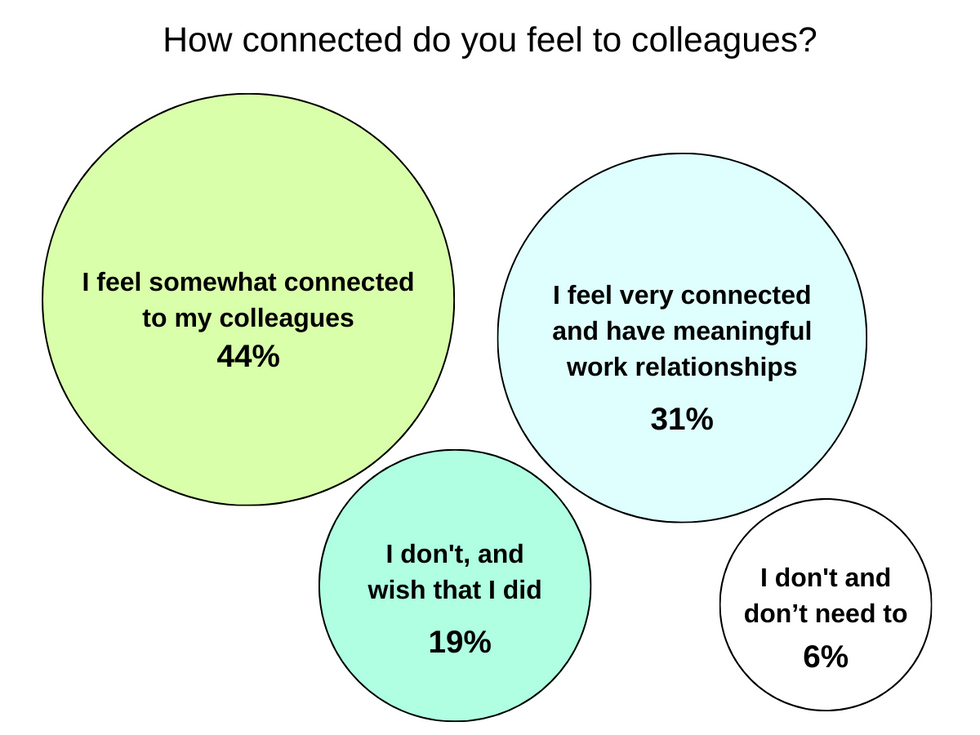
Job insecurity, hybrid work, and wearing more hats than ever are just some of the trends that lead to employees feeling disconnected from one another. With 69% of respondents in 2024 feeling either only somewhat connected to colleagues or not connected to colleagues at all, there’s been no improvement to employee connection since we surveyed diverse talent last year.
We'll keep this short: This lack of connection is a crisis that simply cannot continue to be ignored. In fact, 73% respondents want more team building and camaraderie in 2024.
2024 action items
Socialize during work hours.
Avoid making employee networking yet another outside-of-work task by allowing teams some social time during their work hours. It prevents cutting into their personal time and breaks up the work routine to allow for pure fun and connection, two things that ultimately feed back into high productivity and engagement levels.
Join the metaverse.
The “metaverse” is a concept where people can interact, conduct business, and socialize through virtual reality avatars. It’s still in its early stages, but industry leaders like Meta, Microsoft, and Roblox have already created their own metaverses and experimented with using these virtual gathering places as connection hubs for dispersed teams.
Foster belonging through community engagement.
At PowerToFly, we define belonging as a person’s own perception of acceptance and whether they feel heard, seen, and recognized for their contributions. To foster belonging, helping workers to feel connected to their values within their work environment can go a long way, and wider community engagement represents a unique opportunity to make that connection real. Give employees paid time off to, for example, participate in a tutoring program for a local community college. If students have a positive experience, they may become future candidates or brand ambassadors in your target talent community. This builds diverse early career pipelines. Plus, your current employees get the chance to give back, cross-pollinate teams, and socialize.
Launch Lunch & Learns.
Structured socializing can be a good way to motivate employees to engage with one another across demographics. Lunch & Learn events are a popular activity for a biweekly lunch hour. Whether held at work or even at a quiet cafe, they involve providing food and an educational video or presentation for a small group. After the learning portion, the group practices their new skill or offers reflections on what they learned. This can be anything from how to tie a balloon animal to crocheting a knitted cap to a cooking lesson focused on one culture’s cuisine — which you then get to eat together! Check if any of your employees has a skill or talent that they would like to share, and show employees that their out-of-work personas are valued, too.
6. Double down on DEIB.

When it comes to DEIB, employees are struggling to see true impact, and they want more. Just 11% of survey respondents “strongly agree” that they can see the effects of DEIB efforts at their organization. Meanwhile, respondents said they want to see more DEIB training (64% overall and 73% of LGBTQIA+ respondents), more diverse leadership (74%), and a more diverse workforce (67%) this year.
Simply put, underrepresented workers want to see results. Research shows that employees pay attention to DEIB goals, especially in regards to the success — or lack thereof — of those efforts. One study revealed that only 37% of employees feel their company has made true progress, despite 97% of HR leaders reporting attempts at progress.
Our survey revealed the same. Despite companies’ efforts, many workers say they continue to experience unfair treatment due to factors like their gender (something 35% of respondents have felt unfairly treated for), race (20% of respondents), age (36% of respondents), neurodivergent status (10% of respondents), and socioeconomic background (13% of respondents). Discrimination in the workplace continues to be a national and international problem. In the U.S., 61% of all people have witnessed or experienced discrimination based on age, race, gender, or sexual orientation in the workplace.
The professionals we heard from reported tangible negative outcomes as a result of discrimination.
Because of identities they hold, survey respondents said they’d received fewer professional development opportunities (39%), fewer promotions (37%), and fewer raises (31%), experienced microaggressions (37%), and faced general job insecurity (30%). As a result of these real impacts, underrepresented workers demand real action in order to build trust in their company.
Knowing that diverse workers still face discrimination, what’s being done about it?
Only 18% of our survey respondents were satisfied with the stances their company has taken on DEIB issues, with 44% wanting stronger stances on racism and ethnic discrimination, 37% on ageism, 34% on misogyny and gender based discrimination, and 21% on neurodiversity.
Relatedly, respondents wanted more safe spaces for tough conversations in 2024, with patterns emerging around racial identity and sexuality; while 68% of White and 63% of non-LGBTQIA+ respondents wanted this, 85% of Black, 78% of Latino, 78% of Asian, 100% of Indigenous, and 87% of LGBTQIA+ respondents did.
We know that high employee trust levels can reduce employee turnover by a staggering 87.2% in a single company. Knowing that DEIB efforts that drive results build trust, what can be done to address the obstacles underrepresented workers are continuing to face?
2024 action items
Start with a DEIB assessment.
Do you have demographic and background data on your employees? How do they feel about your DEIB efforts so far? What are your levels of absenteeism and retention? How are your reviews on Glassdoor? You need the answers to all these questions before you move forward with your DEIB efforts in 2024 — meaning, sending out a DEIB-informed employee survey should be a top priority.
Share what’s under the hood.
Transparency builds trust. Share your DEIB data publicly. Industry leaders like Salesforce publish their DEIB goals and metrics on their website. A publicly available diversity and inclusion statement is a definite starting point in making your anti-discrimination stance visible and strong.
Examine all your policies through a DEIB lens.
That means taking a look not just at job descriptions, screening and hiring practices, and your onboarding procedure, but at all touchpoints in the employee lifecycle. Look at annual assessments, promotions, benefits packages, work facilities, dress code, and internal and external communication to ensure you’re incorporating DEIB practices throughout all the ways your employees experience work.
Bring in an expert.
DEIB consultancy services, like the ones offered by PowerToFly, will help you grow and retain your talent by identifying challenges and approaching them with data-driven solutions and a long-term strategy. Explore more solutions, put together by DEIB industry veterans, in our recommended resources section.
In their words: Direct feedback from talent
text

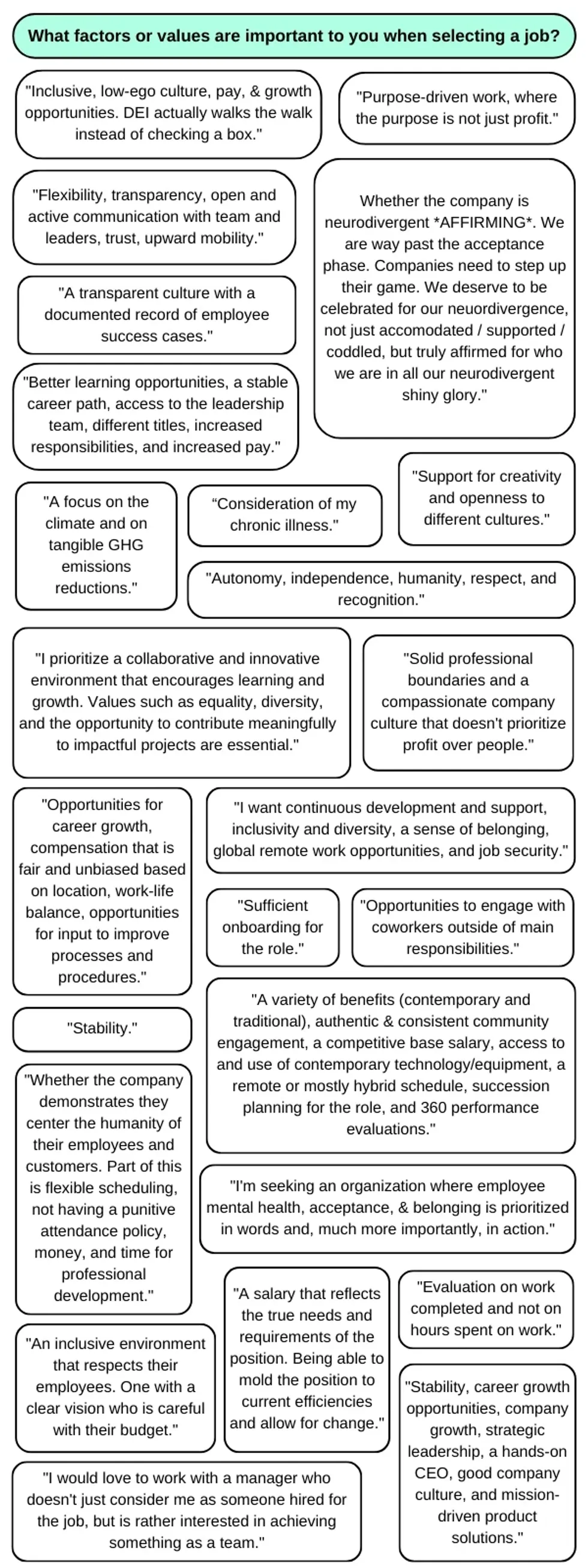
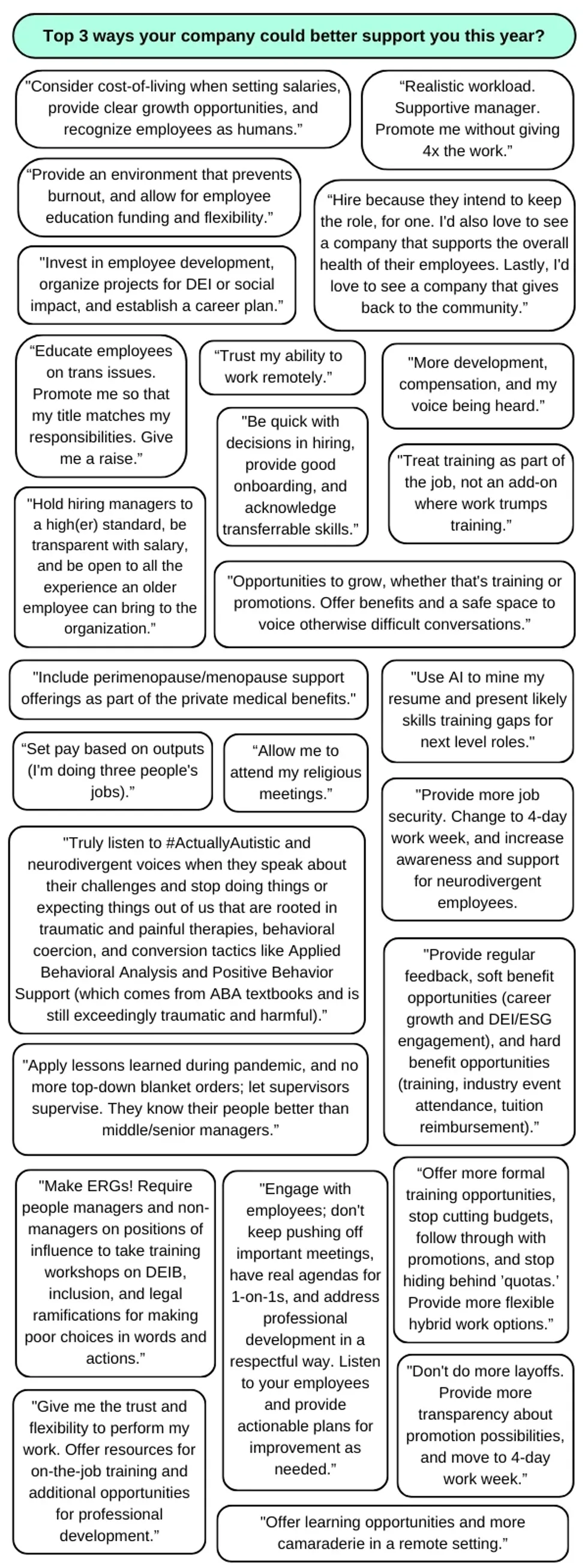
Next steps and recommended resources
The nature of work continues to adapt to the social, political, economic, and environmental changes that affect broader society. PowerToFly’s 2024 research shows that underrepresented workers are engaged and interested, but struggling to feel connected and heard. Organizations can step up to provide that connection.
Upskilling to meet the demands of AI in the workplace, implementing sound career paths, prioritizing professional development, and fostering connection with fellow employees are just a few messages that came through loud and clear from our data. To continue with this work, here are a few additional resources to power your DEIB talent attraction and engagement efforts in 2024.
- PowerToFly’s Resources for Employers. An extensive library of articles, reports, and white papers with expert advice and thought leadership on a broad range of HR and DEIB topics.
- PowerUp, a holistic learning platform with self-paced courses, resources, crash-course videos, trending DEI conversations, and SHRM and HRCI credits to improve your employer brand.
- PowerPro, the first all-in-one diversity recruiting software with 17 million+ diverse candidate profiles and AI Talent Match, helping you to pull a list of diverse candidates whose resumes most closely match each role you have open in seconds.
- A list of free diversity & inclusion training materials for 2024.
- 50 diversity & inclusion survey questions, to help inform your own employee engagement and experience surveys this year. (Want strategic, tailored support to help you implement effective and DEIB-backed employee surveys at your organization? Learn about our DEIB consulting services.)
- A list of 11 diversity & inclusion courses to drive employee retention, learning, and growth in 2024.
- Our 2023 and 2022 What Diverse Talent Want reports, for previous years’ insights, data, and recommendations.
Methods
Participants
We conducted a survey of 634 professionals in our community about their goals and wants for 2024. They were given the option to share self-identifying information.
Gender identity
441 participants opted to disclose their gender identity in a “check all that apply” survey question: 80% identified as women, 14% identified as men, 2% identified as nonbinary, 1% identified as transgender, 6% identified as cisgender, and 1% identified as another gender identity. At 3%, our pool of respondents who identified as trans and nonbinary is nominally higher than the overall percentage of people with these two identities (1.6%) in the U.S.
Race and ethnicity
441 participants opted to disclose their race/ethnicity in a “check all that apply” survey question: 34% selected White or Caucasian, 22% selected Asian or Asian American, 21% selected Black or African American, 15% selected Hispanic or Latino, 7% selected “another race/ethnicity,” 2% selected Indigenous or Native American (roughly in keeping with the United States’ 2.6% population), and less than 1% selected Native Hawaiin or other Pacific Islander (roughly in keeping with the United States’ 0.4% population).
Of those who selected “another race/ethnicity,” free-form responses included: “African,” “Black African,” and “White African” (multiple responses); “Indian” (multiple responses); “Middle Eastern” (multiple responses); “White/Slavic ethnicity;” “Jewish;” “Eastern European;” and “Mixed Race” and “Two or More Races (Not Hispanic or Latino).” This points to the prevalence of individuals with these racial or ethnic identities not feeling well represented by the options included in many U.S. demographics surveys, and it may also indicate the benefit of including an explicit “Mixed Race” option even on surveys with “check all that apply” functionality.
Age
441 participants opted to disclose their age: 7% selected 18-24; 24% selected 25-34; 36% selected 35-44; 23% selected 45-54; 7% selected 55-64; and less than 1% selected 65+. Relatedly, when asked for their career stages, 441 participants answered that they are Entry Level (21%), Mid Level (41%), and Senior Level (34%).
LGBTQIA+
When asked whether they identified as part of the LGBTQIA+ community, 441 participants chose to answer. Of these, 12% said they identify as part of the LGBTQIA+ community — higher than the overall U.S. population of 7.1% LGBTQIA+ identifying people — and 81% said they do not. This may be reflective of our survey drawing a younger group of respondents compared to the overall U.S. population; 67% of our participants were aged 44 or under, and Gallup reports that a higher percentage of those generations (21% of Gen Z and 11% of Millennials) identify as LGBTQIA+ compared to older generations.
Location
441 participants chose to disclose the country they live in in a free-form response field. A majority (60%) live in the U.S. The next most-common answer was India (8%), followed by: Canada and Nigeria (both 3%); Kenya and the U.K. (both 2%); France, Spain, Mexico, Australia, Colombia, Jamaica, South Africa, Germany, and Brazil (all 1%); and a wide range of other countries, from Peru to the Philippines, accounting respectively for less than 1%.
Caregiver status
441 participants chose to disclose whether they’re a primary caregiver (to biological, adopted, or foster children, to parents, or within a different context): 53% said they aren’t a primary caregiver, 41% said they are, and 6% selected “would rather not say.”
Immigrant status
441 participants chose to disclose whether they and/or their parents are immigrants in a “select all that apply” survey question. Of these: 19% identified as immigrants themselves, 15% said their parents had immigrated, 9% said they live in a different country from the one they were born in but do not identify as an immigrant, and 46% said that multiple generations of their family had lived in the country they live in (which shouldn’t automatically be read as respondents who are neither immigrants nor first-generation immigrants).
Free-form responses included: “I don’t know all of my family history – there isn’t a box for unknown or adopted;” “political asylee;” “history of family being slaves brought to South Carolina;” “in Germany on a Job Seeker Visa;” “I emigrated from another country to the U.S. with my parents at 1+ years old — I am an American citizen;” and “I am a descendant of chattel slavery — my ancestors did not immigrate here.” These responses show the value of including free-form response options in demographics surveys and point to the breadth and complexity of many people’s relationships to geographic identity and heritage.
Industry
Of the participants who said they’re either seriously or casually job searching, 445 chose to share which industries they’re looking for work in via a “select all that apply” survey question. Below, see how they responded. For participants who selected “other,” their free-form responses included: “Hospitality,” “Engineering,” “Information Technology,” “Environmental Management,” “Utility,” “Energy,” “Sustainability,” “Greentech,” “Management Consulting,” Fintech, Supply Chain, Law, Automotive, Human Resources, Publishing, Healthcare Tech, “Gaming,” “DEI,” “Transportation,” “Sports and Entertainment,” “Emergency Management & Preparedness,” “Customer Success,” and “Procurement.”
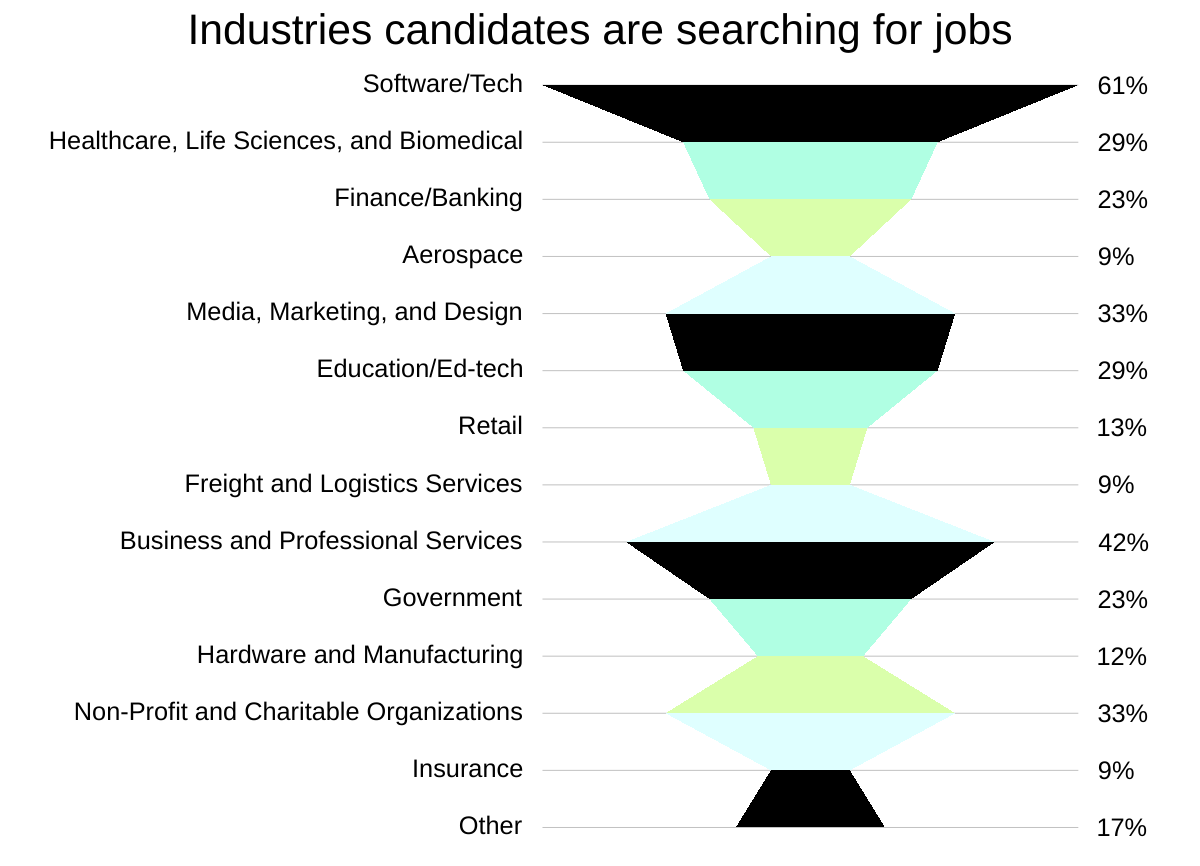
Measures
Participants completed a 34-item online survey with an additional 7 optional demographics questions powered by SurveyMonkey. Participants were informed that their responses would be anonymous. The survey was advertised in our newsletters, on PowerToFly’s LinkedIn page and our other social channels (paid and organic), and in a PowerToFly staff email signature. The bulk of participation came from newsletter readers. A survey link was also shared with PowerToFly clients and external partners. Participants who completed the entire survey and shared their email were given the chance to win a free resume review with a PowerToFly hiring expert, awarded to five randomly selected participants. The survey was live between November 28, 2023 and January 16, 2024.
Limitations
This survey aimed to better understand the needs and wants of underrepresented talent by asking the diverse members of PowerToFly’s community to share their experiences. While the sample in our survey can be seen as generally representative of the PowerToFly community as a whole, the results of this survey are not automatically generalizable to the wider U.S. or global population. Individuals join PowerToFly in order to advance their careers and find organizations committed to DEIB; as such, their expectations for career development opportunities and DEIB initiatives are likely higher than those of the general population. Additionally, while we attempted to collect and report on response trends between different identity demographics where relevant, our choice to make demographic responses optional as well as our primary aim — to speak to the needs of underrepresented talent as a whole in one report — eclipsed certain opportunities to do targeted dives into the views and experiences of any one single identity group. We know that many groups, for example veterans, neurodivergent talent, and members of the LGTBQIA+ community, face unique challenges in the workforce, and future identity-specific reports from PowerToFly will aim to examine these.
Diversity recruiting, made simple.
PowerPro is your AI-driven, SaaS solution to growing diverse teams.
